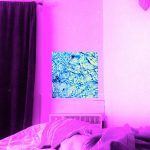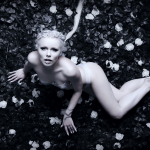Warning! There’s plenty of spoilers for ‘Us’ in this review!
Writer and director Jordan Peele aims high with Us, the hyped psychological horror film out today that sees a family terrorized by mirror images of themselves. While trailers and previews for the film did a good job at making it seem like this was all the film was about, there’s more than meets the eye, with Us being a strong release alongside other Blumhouse productions like Get Out.
The film follows Adelaide Wilson, played by Lupita Nyong’o and in flashbacks by Madison Curry, a woman who experienced a traumatic experience in a hall of mirrors on a trip to the beach with her family as a young girl. Among all the mirrors, she spots her doppelgänger and finds herself traumatized. Once she’s reunited with her family, she’s near mute and put into therapy to find ways to overcome her PTSD.
In the present, Adelaide seems well adjusted but still a little nervous about returning to the Santa Cruz beach where it all happened. Her husband Gabe (Winston Duke) and two children Zora and Jason (Shahadi Wright Joseph and Evan Alex) are enjoying their time at the beach and their beach house — until Jason spots a family in red holding hands and standing outside in the lawn.
Part of the subtle brilliance in Us is how as the film unfolds, this first section feels very predictable. The scares are minimal and just precursors of what’s to come. The film leaves a sense of mystery in the air as to who the family outside in the lawn could be, although a frightened Adelaide knows all too well who they are.
Those watching the film and trying to piece together the puzzle and looking for the symbolism they’ve come to expect in a Peele film will find themselves lulled into a sense of security, thinking they know where Us is taking them. In the end, it’s all so much weirder than anyone could imagine.
The soundtrack and audio editing work superbly with tight cinematography during the scenes where the doppelgängers force their way into the Wilson house. All the speakers are used to good effect, creating space and scares as the Wilsons are chased and hunted. Soon enough, the doppelgängers in red corral the Wilsons into the living room, wielding their shiny scissors and demented grins.
Of the doppelgänger family, only Red (Adelaide’s doppelgänger) is capable of really talking, and she tells the Wilson family a story of shadows and tethers after forcing Adelaide to handcuff herself to the table so she can’t escape. The princess (Adelaide) lives happily on land while her shadow self (Red) is forced to mimic the same life but beneath. Red is quite the cunning matriarch of the doppelgänger family, and she sends the other three off to terrorize their above-ground counterparts.
The scenes that follow serve their purpose to build tension and elicit scares, and thankfully they also help to move the story along in the end. The scenes aren’t much more than jump scares that inch the story along in the direction it needs to go, but it still makes for a very interesting game of cat and mouse to watch.
When the family are finally able to escape their counterparts and regroup, they naturally flee and make their way to their friends’ house across the lake. It’s here that we learn these doppelgängers aren’t just twisted versions of the Wilson family; the Tyler family household has been taken over by their own versions of these red robed madmen as well. By the time the Wilsons get there, the entire family has already been murdered, and their doppelgängers are waiting to greet the Wilsons (with some good old fashioned violence.)
The Tyler family plays a minor role in Us, but it’s worth noting the depth that Elisabeth Moss brings to her role as the Tyler’s matriarch Kitty (and her role as the doppelgänger, Dahlia.) Earlier on the beach, Kitty talks to Adelaide about having work done to remain younthful, and later we see Dahlia take her scissors and cut her face open in front of a mirror, grotesquely but effectively showing the connection between the shadows and the people to whom they’re connected. Do these shadow people truly have any free will? And if not, where does this violence come from?
The stakes get high as the Wilsons have to battle the doppelgänger Tyler family for safety. They eventually win and have a brief respite, watching TV and seeing that doppelgängers are taking over America, coming up from tunnels beneath the ground and forming a wall similar to the 1986 Hands Across America that was shown at the start of the film. Adelaide insists the family needs to stay moving, and her logic is sound; these doppelgängers know how they’d react and where’d they be going because, well, they are mirrors of themselves.
Once the Wilsons found the courage to murder the Tyler family doppelgängers, its no surprise that they’d be used to the bloodshed and ready to take out their own shadow selfs. There’s even some humor thrown in throughout the film, especially when the Wilsons argue about who is going to drive the getaway car and comparing their body counts to show superiority. The script’s humor does a good job at giving the audience a brief moment to relax and chuckle before pulling them back into the tense battle unfolding.
It’s worth noting though that while some moments are obviously there for some comedic relief, other times the dialogue becomes funny for the wrong reasons. This is mostly a result of Nyong’o’s delivery as Red, using a dry, raspy voice and wild eyes to portray the character’s mental state. Nyong’o remains committed and is 100% in character no matter which side of the mirror she’s playing, but sometimes the shadow self just becomes a bit too absurd.
Little moments like this make it much harder to suspend your disbelief than in Get Out for example. It’s not until the climax of the film that the viewer learns what these doppelgängers truly are and how they came to be, and that makes it hard to truly engross yourself into the film as something that’s actually happening. Us is clearly a psychological horror and thriller, but until the source of these doppelgängers is revealed, there’s loose ends floating about for the viewer that can leave you wondering — is there about to be a fantasy element thrown in? What other spanners will be thrown into this work?
Of course, the payoff is worth the confusion. It is revealed that the doppelgängers were put into the tunnels for all this time as part of a plan to control people living on the surface. When it all failed to truly work, the doppelgängers were left below, miserable and controlled by their surface-dwelling counterparts instead. As Red lived out her life controlled by Adelaide up above, she was the only one smart enough to start planning for revenge.
In the film’s final scenes where things really start happening fast, there’s quite a bit of convenient coincidences (perhaps like the ones Adelaide mentioned earlier in the film?) that help drive the story home. Why is the funhouse Adelaide found herself in as a child connected to one of the underground tunnels where the doppelgängers were living? Sure, some logic could be drawn that an underground tunnel could connect to a beach carnival funhouse, but it seems more unlikely than anything. Likewise, even if this funhouse did connect to an underground tunnel where doppelgängers were living, the viewer is also supposed to believe there’s a massive DC-metro sized escalator that’s still running and lit up, leading Adelaide down the abyss to where her doppelgänger waits? Sure.
These minor grievances aside, the film’s final twist manages to hit the ball out of the park as it’s revealed that on the fateful night in 1986, Adelaide’s tethered shadow self actually takes the young girl down into the tunnels, shackling her to the bed and leaving her unable to escape. Of all the crazy things that unfurl in Us, this is one that was hard to see coming, thanks to the little red herrings and falsely predictable nature of the film’s earlier scenes.
It takes a second watch to truly pick up on the nuances and little clues in Nyong’o’s performance to spot that the Adelaide we’re watching protect her family was once living her life trapped in the tunnels. The twist also adds an interesting layer of depth to the motives and reasonings for Red’s revenge. Of course Red is the only one who could talk or help the others tethered in the tunnels to rise up — she wasn’t born in the tunnels and is arguably the only one who even knows there is life above and just how sweet it is.
Us is a film that leaves more questions unanswered than answered in the end, but it’s still a thought-provoking wild ride. The story is taut and compelling, and it boasts exquisite audio editing and a haunting soundtrack. The film’s cinematography is equally grand, with cinematographer Mike Gioulakis artfully crafting and framing the scenes to create a world that’s wonderfully frenzied.
Nyong’o gives a great performance as both Adelaide and Red, despite the Tethered performance sometimes feeling more unintentionally funny than frightening.
Us manages to bring some pretty haunting topics to the forefront of discussion, including oppression and the American dream, while still delivering psychological thrills that’ll have you thinking for days to come.




Loading…